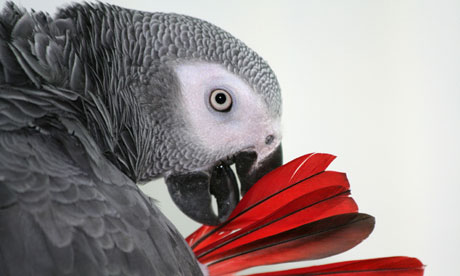Conservationists hail breakthrough in regional co-operation to fight illegal traffic in ivory, parrots, skins and live animals
- The Observer,

Sting operations by wildlife activists in central Africa have broken up highly organised smuggling rings sending endangered species abroad, leading to the arrest of key dealers and the recovery of hundreds of kilos of ivory, turtle shells and animal skins.
The clampdown took place across four neighbouring countries: Cameroon, Gabon, the Central African Republic and the Republic of Congo.Observers said the arrests last week, co-ordinated by the Last Great Ape Organisation (Laga), a wildlife law-enforcement NGO, in Cameroon, Gabon, the Central African Republic and Congo-Brazzaville, marked a big step towards regional enforcement of the laws protecting endangered species.
In Gabon, undercover agents posing as smugglers picked up 16 dealers in possession of 150kg of illegal polished ivory. The haul, estimated to be worth about £90,000 on the international market and probably destined for China, the world's leading market for "white gold", was going via Nigeria, one of the main smuggling routes. All 16 were remanded in custody, having been refused bail following the operation, which focused on a hotel, a local market and a sculptor's studio following a long investigation.
Luc Mathot, of the agency AALF (appui à l'Application de la Loi sur la Faune), who proposed the project to the government, said it was the first time ivory dealers in the country had been put in jail. "This shows that the Gabonese authorities are now prepared to monitor, hunt down, condemn and imprison ivory dealers – that the law on ivory dealing in Gabon is finally being enforced," he said.
In Cameroon, three dealers trading 17 turtle shells were arrested. A cargo of 1,000 African grey parrots worth an estimated £65,000 was intercepted being smuggled into Nigeria and a policeman was arrested on suspicion of accepting a £2,000 bribe to release it and allow it on its way.
The operation in the Central African Republic recovered seven leopard skins, two lion skins and two tusks concealed beneath a pile of cowhides in a dealer's truck. He was arrested. The skins were thought to be destined for Europe or the US to decorate wealthy homes. On the same day, wildlife activists in Ouesso in the north of Congo-Brazzaville found a further 30kg of ivory.
Ofir Drori, the founder of Laga, said the co-ordinated campaign was a breakthrough in a region where countries often sign up to global protections for animals but poor legislation and weak enforcement mean they fail.
"This is the first time we have experienced such a regional crackdown. African governments have started realising international trafficking has to be fought internationally," he said. "These co-ordinated arrests in four neighbouring countries are a warning to the international trafficking rings – no longer can you hide on the other side of a border.
"Traffickers are untouchable and often enjoy complicity with government officials. Conservation in central Africa is a massive failure hiding behind so-called success stories. We would never claim to be a success story – the smugglers still have the upper hand and we are just at the beginning of our fight.' Drori said that the slaughter of animals for the trade was driven by demand from overseas. An ivory baron in China or a trophy hunter in America would place an order that would then trickle down through the criminal network to central Africa.
The smugglers were not lone operators but part of a sophisticated mafia which had grown over the past couple of decades. "Wildlife extinction doesn't start with poachers, it starts with wealthy white-collar criminals who have been operating in central Africa for over 20 years," he said. One of the major obstacles facing wildlife law enforcement is tackling the corruption endemic within central Africa. Congo-Brazzaville, Gabon, Cameroon and the Central African Republic are persistently ranked by Transparency International as some of the most corrupt countries in the world.
Revenue generated from the illegal wildlife trade, the single greatest threat to some species' survival, is estimated to be in the region of $10bn to $20bn, just behind illegal drug and firearm sales, according to the UN Congress on Crime. Sometimes drugs and wildlife trafficking work hand in hand. One chimpanzee was found sandwiched between 50kg of cocaine and marijuana when a trafficker was arrested in Cameroon en route to Nigeria four years ago.
Often the illegal trade in animals is not even remotely clandestine. In 2008, a baby male hippopotamus was put on an Ethiopian airlines flight from Douala, Cameroon's economic capital, and flown to Lahore zoo in Pakistan. Three traffickers, currently under investigation, reportedly paid $80,000 for the hippo and smuggled it out using forged government documents. Further proof that conservationists are failing to protect endangered species is the disappearance of the West African black rhino, which was last seen in northern Cameroon in 2008. At the end of 2009, Sierra Leone announced it feared it had lost the last of its elephants to poachers, while fewer than 10 elephants remain in Senegal.
No comments:
Post a Comment